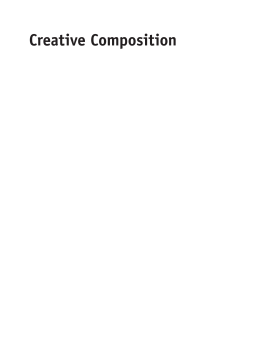
Additional Information
Book Details
Abstract
For decades theorists have opined that the lines between creative writing and composition need to be lifted, yet little has been written about the pedagogical methods that allow a cohesive approach between the disciplines. This book brings together contemporary authors and well-respected creative writing instructors and theorists to explore ways creativity in composition may be encouraged in student writers. The question in this anthology is not ‘Can writing be taught?’ but ‘How can we inspire students to embrace the creative process no matter what they write?’ This book offers multiple strategies to merge the best practices of teaching writing, regardless of the genre.
This volume offers a fascinating and useful discussion of creative composition. It is a tricky subject to define and it is certainly difficult to establish whether we can or should teach it. Here the contributors explore the topic thoroughly. The reader is offered a wealth of diverse examples and ideas.
Gill James, University of Salford, UK
One of the rewards of a long career is the opportunity to see new ideas take hold and hang on for a new generation of scholars. This book represents the best current thinking about Creative Writing Studies and the composition-creative writing connection and nicely demonstrates how far we've come.
Patrick Bizzaro, Indiana University of Pennsylvania, USA
Danita Berg is English Department Director at Full Sail University, Orlando, Florida. Her research interests include creative writing studies, women's voice in writing, and invention. She is also Founder and Co-Editor of Animal: A Beast of a Literary Magazine.
www.danitaberg.wordpress.com
Lori A. May is a writing mentor at University of King’s College, Halifax, Nova Scotia. She is Founding Editor of Poets’ Quarterly (www.poetsquarterly.com), and her other books include The Write Crowd: Literary Citizenship & the Writing Life (Bloomsbury, 2014) and The Low-Residency MFA Handbook: A Guide for Prospective Creative Writing Students (Continuum, 2011).
www.loriamay.com
Table of Contents
| Section Title | Page | Action | Price |
|---|---|---|---|
| Contents | v | ||
| Contributors | vii | ||
| Foreword | xi | ||
| Introduction | xv | ||
| 1 On Essaying | 1 | ||
| 2 Eat Your Spinach! Why a Blend of Personal and Academic Discourses Matter | 10 | ||
| 3 Writing by Creation, with Response, in Experience | 16 | ||
| 4 Give it a Taste: Serving Creative Writing in Small Doses | 24 | ||
| 5 Wiggling Between the Forms: A Cross-Genre Approach to Writing | 30 | ||
| 6 Writing to Discover: Creative Nonfiction and Writing Across the Curriculum | 35 | ||
| 7 Creative Writing’s Five Stages of Development: The Mind of the Creative Writer in the Composition Classroom | 47 | ||
| 8 Sought-After Sophistications: Crafting a Curatorial Stance in the Creative Writing and Composition Classrooms | 59 | ||
| 9 Audience Resurrected: Restoring Motive and Purpose to Creative Writing | 77 | ||
| 10 Lending the Muse a Hand: Expanding the Role of Social Constructivism and Collaborative Writing in Creative Writing Pedagogies | 87 | ||
| 11 Grammar and Creativity in Composition: An Unexpected Nexus | 109 | ||
| 12 Invention in Creative Writing: Explorations of the Self and the Social in Creative Genres | 114 | ||
| 13 Teaching the Exploratory Essay as Pedagogy, Process and Project | 129 | ||
| 14 Beyond Argumentation: Toulmin’s Model as a Dialogic, Processual Heuristic | 138 | ||
| 15 Leave it to the Imagination: Service Learning as Part of an Undergraduate Creative Writing Curriculum | 148 | ||
| 16 Show, Don’t Tell: Using Graphic Narratives to Teach Descriptive Writing | 154 | ||
| 17 A First-Timer’s Approach to Teaching in a Non-Traditional Setting | 169 | ||
| 18 In It for the Long Haul: The Pedagogy of Perseverance | 174 | ||
| Index | 182 |
